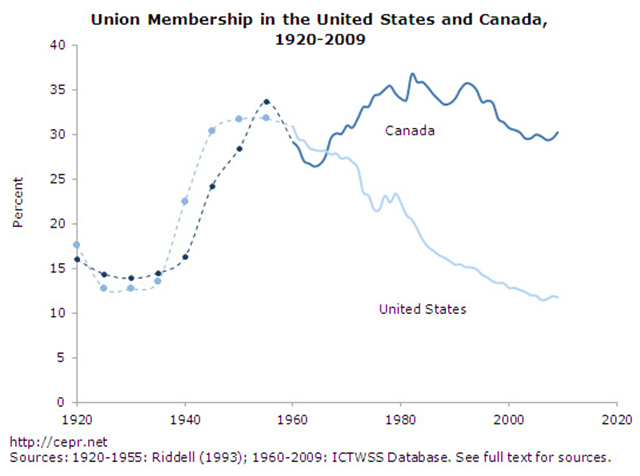Graph of the Day: Union Membership in the U.S. and Canada, 1920-2009
Contact: Alan Barber (202) 293-5380 x115
28 August 2012 Washington, D.C. (CEPR) – Unionization in the United States has been on the decline since the 1960s. While many reasons have been offered to explain this drop in the rate of unionization, a new report from the Center for Economic and Policy Research highlights the roles that employer opposition to unions and weak labor laws have played in this decline. The report, “Protecting Fundamental Labor Rights: Lessons from Canada for the United States,” begins with a comparison of the current state of organized labor in the United States and Canada. It notes that, from the 1920s to about 1960, Canada and the United States had roughly the same unionization rates. But in 1960, the two began to diverge. As of 2011, the unionization rate in Canada stood at 29.7 percent, compared to less than half that in the U.S., at 11.8 percent. The paper then goes on to look at the legal process for forming unions and how impasses in contract negotiations are handled in both countries, reaching the conclusion that these institutional factors help to explain much of the difference in unionization rates. While Canada and the U.S. both have elections as one route to forming unions, Canadian workers in several provinces also have the much faster option of card-check certification. Under card check, once a majority of employees signs cards in support of unionizing, an employer is required by law to recognize their union. In the United States, however, unless an employer voluntarily recognizes a union, workers must first file a petition showing support for unionizing and then vote to unionize in an election before an employer is required to recognize their union. As of 2011, the median amount of time between the petition to form a union and the election was 38 days, and it often extends far beyond this. During this time, U.S. employers usually engage in anti-union campaigns, often committing illegal acts – such as threatening to close the workplace or threatening to fire workers – to discourage them from voting to form a union. In fact, workers were illegally fired in about 30 percent of certification elections in 2007. Unfortunately, the legal response to such practices is slow and ineffective. It is worth noting that union decertification in Canada was no more common in periods where card-check certification was in place than at other times. Opponents of the Employee Free Choice Act, which would have brought card check to the United States, argued that the process would allow unions to bulldoze workers into signing cards, leaving them with union representation even when they didn’t really want it. However, the fact that decertification was no more prevalent under card check than it was under mandatory elections in Canada suggests that this has not been a problem. Finally, the report notes that even after a union has been certified, negotiation of a contract is a much more difficult prospect in the U.S. than in Canada. Though required by law to negotiate with workers “in good faith” to obtain a contract, many employers never reach an agreement with a union. The failure to get a first contract often leads to the union being decertified. In Canada, “first contract arbitration” mandates that if bargaining for a first contract has come to an impasse or if certain conditions have been met, there is a mediation procedure to reach a mutual agreement. Should this fail, arbitration will lead to a legally binding contract. As demonstrated in the full report, the two largest differences in labor policy between the U.S. and Canada – card check certification and first contract arbitration – lead to an environment that is more conducive to forming unions in Canada and goes far in explaining the difference in U.S. and Canadian unionization rates.
